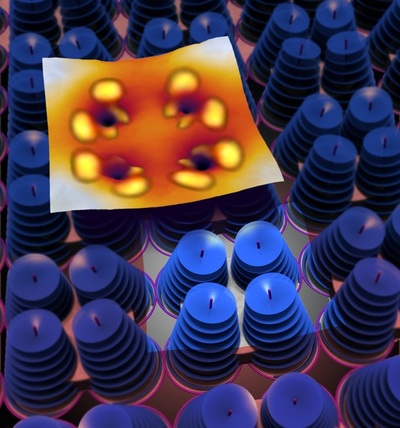Controlling liquid crystal assembly
Directed assembly is a growing field of research in nanotechnology in which scientists and engineers aim to manufacture structures on the smallest scales without having to individually manipulate each component. Rather, they set out precisely defined starting conditions and let the physics and chemistry that govern those components do the rest.
An interdisciplinary team of researchers from the University of Pennsylvania has shown a new way to direct the assembly of liquid crystals, generating small features that spontaneously arrange in arrays based on much larger templates.
Crystals are materials that have molecules arrayed in regular three-dimensional patterns; liquid crystals contain some, but not all, of these patterns, and their molecules can flow around one another and change the direction they face. This behaviour allows defects, places on the surface where the molecular orientation of the liquid crystals is disrupted.
Despite their name, such defects are highly desirable. If the location of the defects can be controlled, the change in pattern or orientation can be put to use. In a liquid crystal display, for example, the crystals’ orientation in different regions determines which parts of the screen are illuminated.
“Liquid crystals naturally produce a pattern of close-packed defects on their surfaces,” Yang said, “but it turns out that this pattern is often not that interesting for device applications. We want to arbitrarily manipulate that pattern on demand.”
Electrical fields are often used to change the crystals’ orientation, as in the case with liquid crystal displays, but the Penn research team was interested in manipulating defects by using a physical template. Employing a class of liquid crystals that forms stacks of layers spaced in nanometres - known as ‘smectic’ liquid crystals - the researchers set out to show that, by altering the geometry of the molecules on the bottommost layer, they could produce changes in the patterns of defects on the topmost.
The molecules can feel the geometry of the template, which creates a sort of elastic cue that is transmitted layer by layer, and the whole system responds.
The researchers’ template was a series of microscopic posts arrayed like a bed of nails. By altering the size, shape, symmetry and spacing of these posts, as well as the thickness of the liquid crystal film, the researchers discovered they could make subtle changes in the patterns of the defects.
For example, a smectic liquid crystal that would naturally form a hexagonal array of dimple-like defects on its surface could be templated to form a square pattern or to have dimples that were more closely or loosely packed.
Critically, these induced defect patterns weren’t one-to-one reproductions of the pattern of posts on the template layer. The researchers were able to generate more complex relationships, such as getting four defects to sit atop each circular post or defects that formed over the points of a triangular post. They were also able to deduce the rules that govern these relationships and predict what defect patterns a given set of post parameters would produce.

The first layer’s molecules tend to be pinned to the edges of the posts so changing a post’s size and shape will change how many defects can sit on its edges at the same time.
The size discrepancy between the posts and individual molecules of the liquid crystal is also a key feature for using this class of liquid crystal in directed assembly. The posts are each a few microns wide and tall, still microscopically small, but large enough to be easily and economically made to specification. This is much more attractive than trying to directly control the size and arrangement of the liquid crystals’ defects.
The liquid crystal layers are very thin, so the defects are on the order of several nanometres across. Those defects would normally be very hard to control, especially compared to the posts, which are more like a few thousand nanometres across.
Beyond sensors and displays, these defects can be used in nanomanufacturing.
“If you make defects like dimples, you could put ink in them and use them like a stamp or you could make the inverse of the dimples and make points, which could be used as localised surface plasmon resonance hot spots for chemical and biological sensing or as a topographic protrusion for creating a superhydrophobic surface,” the researchers claim.
And because the layers of liquid crystals transmit elastic energy, they can also be used to do mechanical work. This means that the top layer could be used as a template to assemble even larger molecules. You could put nanoparticles, quantum dots or carbon nanotubes in the liquid crystal layers and they would be expelled into the defects.
A template consisting of circular posts could even be dynamically altered with heat and an electric field, for example, making the posts in a certain region elliptical. This microscopic geometric cue would travel up the layers of liquid crystal and produce micrometre-scale changes on the surface.
By establishing the mathematical relationships between the post parameters and the surface-layer defects, the researchers are laying the foundation of a directed assembly technique that can be used with any smectic liquid crystal.
By providing a very crude cue, the researchers are achieving exquisite molecular level organisation. Any liquid crystal that makes layers can now be used to make rather beautiful control over textures on the surface.
Light reshapes semiconductors for advanced optical devices
Researchers have shown how light reshapes Janus semiconductors at the atomic scale, enabling...
Novel method to grow ultrathin semiconductors on electronics
Researchers have developed a technique that could speed up the development of next-generation...
Blue LEDs developed to enhance display performance
Researchers have developed a new method for manufacturing light-emitting diodes (LEDs) that emit...




